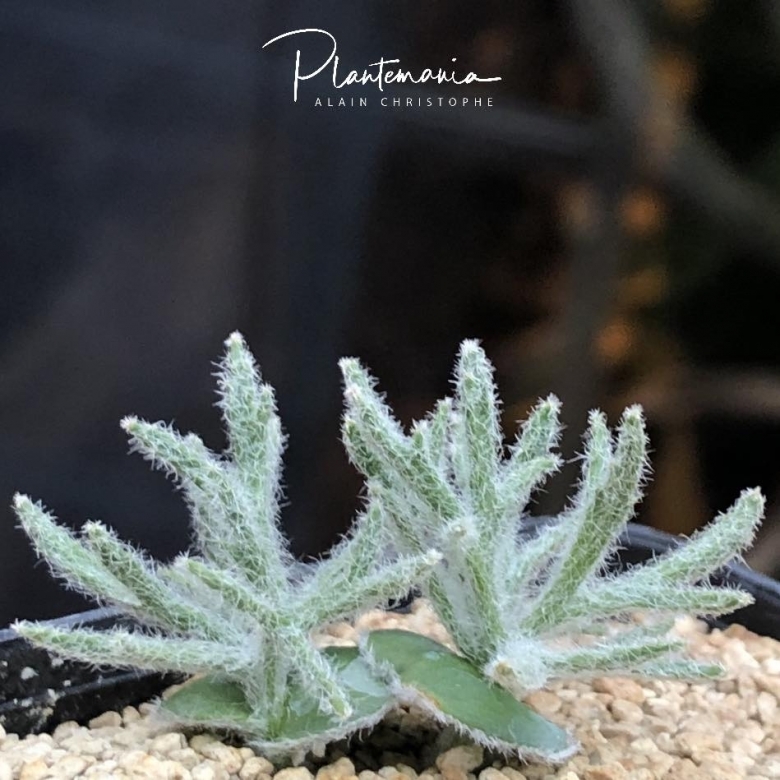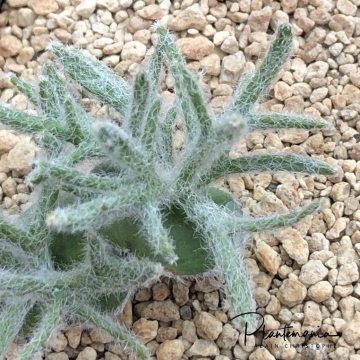
Eriospermum dregei Photo by: © Plantemania
Origin and Habitat: Eastern Cape, Western Cape, South Africa
Habitat and Ecology: Eriospermum dregeiSN|35520]]SN|35520]] grows in the winter rainfall area on very shallow soil and nutrient poor, associated with many other miniature species of specialized growth form such as: Ornithogalum unifolium, Ornithogalum perdurans, Brachystelma luteum, Orthopterum waltoniaeSN|25087]]SN|25087]] and Bulbine mesembryanthoidesSN|22627]]SN|22627]]. The population trend is stable.
Synonyms:
Description: Eriospermum dregeiSN|35520]]SN|35520]] is a small, unusual, geophyte with a below ground tuber (caudiciform). It is very remarkable in particular as to the leaf. This vegetable oddity produces a single leaf blade with branched, featherlike appendage called enations of variable length. They look kind of like fuzzy parsley. Each year the leaf dies in summer and sprouts again in late summer-autumn or so. If it is mature, it should flower in that gap
Leaf: Solitary, hysteranthous (produced after the flowers), erect. The leaf appear to have multiple leaves or leafy/stemmy appendages (enations) rising from a single short stipe (stalk), up to 10 mm long, from the centre of the lamina, but in fact they are outgrowths of a single leaf. These appendages are almost dichotomously branched, with linear, thick and fleshy segments and numerous featherlike branches. There are about five main branches about 18 mm long then much-branched heads, forming a semicircular mop up to 50 mm across, all covered with clusters of long, curly hairs. Contemporary leaf sheath exserted about 15 mm, and are densely covered with hair-clusters often giving a greyish woolly appearance. Juvenile leaves are orbicular to broadly ovate-cordate, 7 mm from apex to the depression and 10 mm wide and does not have enations. Old leaf sheaths are up to 6 cm long and 3-4 mm diameter, widening up to 8 mm near ground level, and membranous.
Tuber: Underground, pear-shaped, irregularly-shaped, or gnarled with rounded warts, up to 40 mm long and 24 mm wide. Skin pale brown, interior pink to maroon red. Growing point basal.
Inflorescence: Solitary, up to 14 cm tall. Peduncle up to 75 mm long, glabrous with barely exserted, membranous bract. Raceme dense, cylindrical or narrowly conical, up to 75 mm long and 30 mm wide, with up to 30 flowers. Pedicels up to 8 mm long.
Flowers: Spreading when fully open, up to 10 mm diameter, triangular. Tepals white with conspicuous green midnerve sometimes overlaid with red streaking. Filaments subequal, fused to the base of the tepals pale yellow. Ovary globose to subglobose, pale green. Style cylindrical, about as long as the ovary, white.
Seeds: Rounded covered all over with hairs.
Bibliography: Major references and further lectures
1) Goldblatt, P. and Manning, J.C. 2000. “Cape Plants: A conspectus of the Cape Flora of South Africa”. Strelitzia 9. National Botanical Institute, Cape Town.
2) Raimondo, D., von Staden, L., Foden, W., Victor, J.E., Helme, N.A., Turner, R.C., Kamundi, D.A. and Manyama, P.A. 2009. “Red List of South African Plants”. Strelitzia 25. South African National Biodiversity Institute, Pretoria.
3) Foden, W. & Potter, L. 2005. Eriospermum dregei Schönland. National Assessment: Red List of South African Plants version 2017.1. Accessed on 2018/11/27
4) R.M.T. Dahlgren, H.T. Clifford, P.F. Yeo, “The Families of the Monocotyledons: Structure, Evolution, and Taxonomy” Springer Science & Business Media, 6 December 2012
5) Gordon Rowley, “Eriospermum dregei”, British Cactus & Succulent Journal, Cactus & Succulent Society, 1993
6) Klaus Kubitzki, “Flowering Plants. Monocotyledons: Lilianae (except Orchidaceae)”, Springer Science & Business Media, 29 June 2013
7) “Botanical Survey of South Africa: Memoir”, Edizions 17-19, 1937
8) Vinay Shah “Succulents from the Winter Rains” BCSS Southampton & District Branch April 2010 Newsletter web: https://www.southampton.bcss.org.uk/docs/Bcss0410.pdf
9) A.P. Dold , “The rediscovery of Ornithogalum britteniae (Hyacinthaceae) and an amendment to the description” South African Journal of Botany 2003, 69(4): 500–504
10) Eriospermum dregei, web: http://urbanehillbillycanada.blogspot.com/2010/12/eriospermum-dregei.html
11) Schönland, Trans. Roy. Soc. South Africa 1: 441 (1910)
12) Perry, P. Lesley, “A Revision of the genus Eriospermum (Eriospermaceae)”
Contributions from the Bolus Herbarium,Volume:17, University of Cape Town,1994
 Eriospermum dregei Photo by: © Plantemania
Eriospermum dregei Photo by: © PlantemaniaSend a photo of this plant.The gallery now contains thousands of pictures, however it is possible to do even more. We are, of course, seeking photos of species not yet shown in the gallery but not only that, we are also looking for better pictures than those already present.
Read More... Cultivation and Propagation: Commercial seed usually does not germinate well because they are shorted lived.










